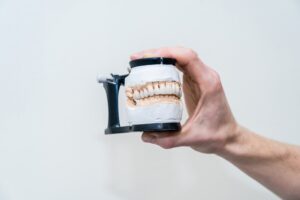How to Ensure Predictable Dental Implant Outcomes?
 To our not-so-distant ancestors, losing a natural tooth would mean the end of it. The luxury of an adequate replacement that is fixed, stable, and durable would be beyond their wildest dreams. The earliest record of dentures dates back to 7th century BC, but it was only decades ago that dental implants, a truly groundbreaking dental restoration solution, became available.
To our not-so-distant ancestors, losing a natural tooth would mean the end of it. The luxury of an adequate replacement that is fixed, stable, and durable would be beyond their wildest dreams. The earliest record of dentures dates back to 7th century BC, but it was only decades ago that dental implants, a truly groundbreaking dental restoration solution, became available.
One of the key drawbacks of dentures is that they inevitably cause damage to the surrounding tissues. Another one is that they are not nearly as effective and comfortable as dental implants. For anyone who has lost or is at risk of losing their natural teeth, dental implants are a smart investment in the future, and for many patients, they are bound to last a lifetime.
But are dental implants right for everyone? If not, what can be done to improve a patient’s odds of a successful outcome?
When it comes to non-removable teeth on implants, patients in Lake Elsinore and other parts of the Temecula region are primarily concerned with one thing: how certain are the beneficial outcomes?
How to maximize predictability in dental implant procedures?
In order to improve the predictability of implant dentistry, it is essential that patients go through an in-depth examination, preparation and treatment planning process. Just because a patient is not the ideal candidate for an All-on-4 dental implant procedure does not mean they cannot be made into one by a competent oral surgeon. Many patients can get All-on-4 dental implants even after suffering significant bone loss. Bone grafting may or may not be necessary, and for many patients, it is not.
How do I know if my dental implant has failed?
The following symptoms may mean that a patient is experiencing dental implant failure:
- Severe pain or discomfort in or around the implant area
- Gum swelling or inflammation
- Loose implants
However, dental implant failure is highly unlikely to occur if the consultation, preparation and treatment planning stages were executed properly and high-quality dental implants are used for the procedure.
How are teeth attached to implants?
In a single implant placement procedure, the crown is attached to the implant either by using cement or screw retention. Many dental specialists opt for the latter.
In an all-on-4 dental implant procedure, patients go through two sets of teeth. A provisional dental bridge is attached to the 4 to 6 dental implants inserted into the jawbone on the day of the surgery. The final prosthesis is attached once the patient has fully healed. Once the implants have been fully secured, abutments are attached to them and the bridge is fastened over those.
The All-on-4 concept has a considerable advantage over the one implant per missing tooth solution, as only 4 to 6 implants are needed to secure full restoration in the upper arch, lower arch, or both arches. Whether a patient needs 4 or 6 implants is determined on a case-by-case basis.
 Non-removable teeth on implants for patients in Lake Elsinore and the area
Non-removable teeth on implants for patients in Lake Elsinore and the area
The All-on-4 concept is a sophisticated dental restoration solution and your new teeth are functional immediately. The procedure is relatively quick and straightforward. In return, patients receive a set of fixed, non-removable teeth that look and feel natural, with their chewing capacity restored almost to the maximum.
If you are concerned about the costs of the procedure, don’t be, as dental insurance may cover up to 50-60% of the cost. Additionally, the consultation patients from Lake Elsinore and other parts of Riverside County can get at our office is absolutely free of charge, as are the X-rays. You get a chance to discuss your outcomes 1-on-1 with Dr. Tsvetov, who is an experienced oral surgeon known for being a compassionate professional.
Do not hesitate to call today and schedule your free consultation.
Comments are closed.


 Non-removable teeth on implants for patients in Lake Elsinore
Non-removable teeth on implants for patients in Lake Elsinore